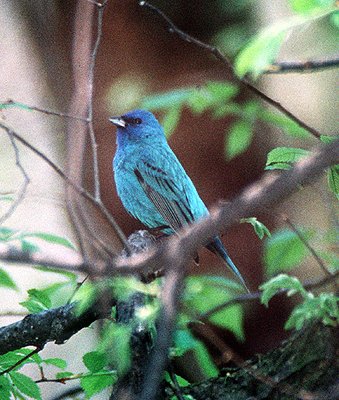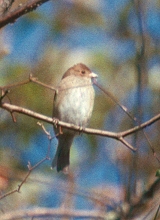|
Indigo Bunting Passerina cyanea Gorrión Azul,
|
 |
|
Breeding male - Photo: G. Beaton
|
|
Indigo Bunting Passerina cyanea Gorrión Azul,
|
 |
|
Breeding male - Photo: G. Beaton
|
|
IDENTIFICATION: A small finch, with a conical bill, and bright blue breeding plumage. In winter the male resembles the female: dull brown, with only faint streaking on the sides. Length: 11.5-13.0 cm.; weight: 12-18 g. VOICE: The call note is a buzzy "cheet." Just prior to departing on spring migration the male may give its song: a high-pitched series of distinct, paired notes. Audio (M. Oberle). HABITAT: Brushy pastures, coastal areas, roadsides and agricultural fields. HABITS: Forms loose flocks in winter, sometimes with grassquits, to search for small seeds and occasional insects on the ground or in low bushes. At night the flock roosts in bushes or tall grass near feeding areas. The male migrates to the breeding grounds in North America before the female, and sets up breeding territories in brushy fields, pastures, roadside edges or forest clearings. Young males learn the species’ complicated song during the first breeding season by interacting with more experienced males singing nearby. Most pairs are monogamous, but some males will have more than one female nesting in their territory. The female builds the nest alone, usually in a low tree branch or bush. She lays 3-4 eggs and begins incubating after the last egg is laid. The incubation period is 12-13 days, and young birds open their eyes 5-6 days after hatching. The female does all the brooding and most of the feeding of the chicks. Like many other land birds, the female keeps the nest clean by either eating the fecal sacks produced by the chicks, or carrying the fecal sacks some distance from the nest and dropping them, thus diverting predators’ attention. The young leave the nest 9-12 days after hatching, and the parents stop caring for the young three weeks after the chicks have left the nest. Like many other birds, the young learn to orient themselves by the stars in the night sky over their breeding grounds, and use this skill to migrate at night.
STATUS AND CONSERVATION: A rare, localized species in Puerto Rico from October to April. The world population is estimated at 10-20 million breeding pairs, despite high mortality on migration, and nestling loss from cowbird parasitism. This species probably increased on its breeding grounds because of the increase in abandoned fields in the middle of the 20th Century. But with urban sprawl and more intensive agriculture, this species may decline somewhat in coming years. RANGE: Breeds in eastern, central, and southwestern North America, and winters from southern Florida and southern Mexico through Central America and the Caribbean to northwestern South America. Regular places to find this species are in grassy fields near Cabo Rojo and at Caño Tiburones (e.g. 3 March and 9 March 2000). TAXONOMY: PASSERIFORMES; CARDINALIDAE |
 |
|
Female - Photo:
G. Beaton |
|
References Arendt, W.J. 1992. Status of North American migrant landbirds in the Caribbean region: a summary. Pp. 143-171 in Ecology and conservation of neotropical migrant landbirds (J.M. Hagan III and D.W. Johnston, eds.) Smithsonian Instit. Press, Washington, D.C. Bent, A.C. 1968. Life histories of North American cardinals, grosbeaks, buntings, towhees, finches, sparrows an allies, part 1. Smithsonian Instit. U.S. National Museum Bull. 237. (Reprinted by Dover Press, NY, 1968). Payne, R. B. 1992. Indigo Bunting (Passerina cyanea). No. 4 in The birds of North America (F. Gill, A. Poole, and P. Stettenheim, eds.). Acad. Nat. Sci., Philadelphia, PA, and Am. Ornithol. Union, Washington, D.C. Raffaele, H.A. 1989. A guide to the birds of Puerto Rico and the Virgin Islands. Princeton. Raffaele, H.A. 1989. Una guía a las aves de Puerto Rico y las Islas Vírgenes. Publishing Resources, Inc., Santurce, PR. Raffaele, H.A., J.W. Wiley, O.H. Garrido, A.R. Keith, and J.I. Raffaele. 1998. Guide to the birds of the West Indies. Princeton. Wunderle, J.M., Jr., and R.B. Waide. 1993. Distribution of overwintering nearctic migrants in the Bahamas and Greater Antilles. Condor 95:904-933. Next related species in taxonomic order Previous related species in taxonomic order |